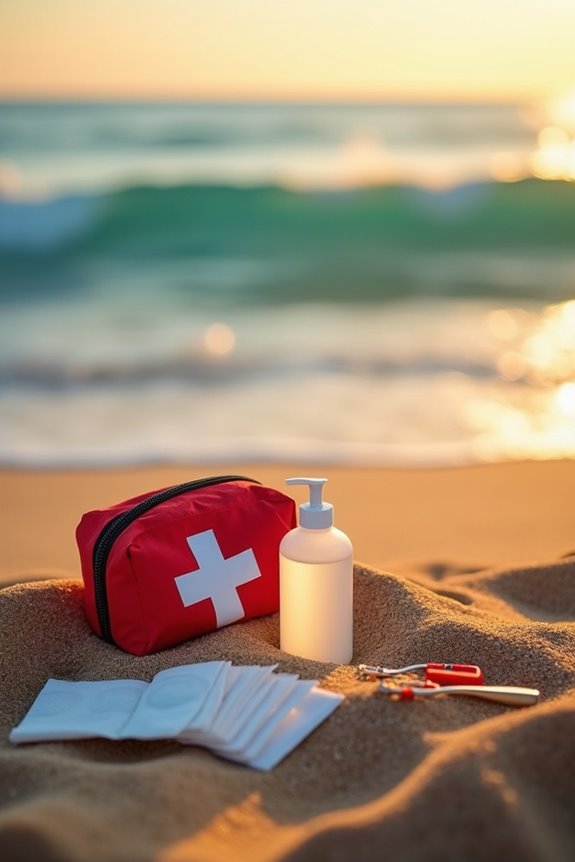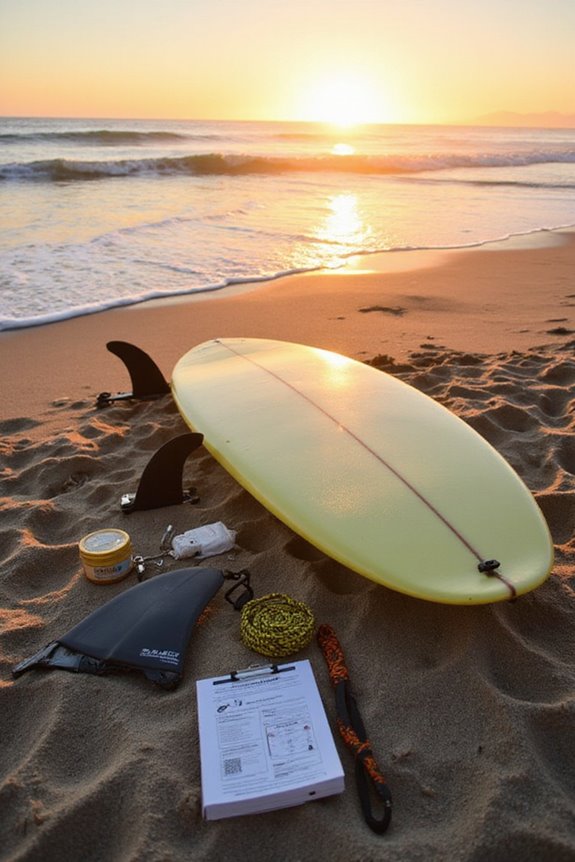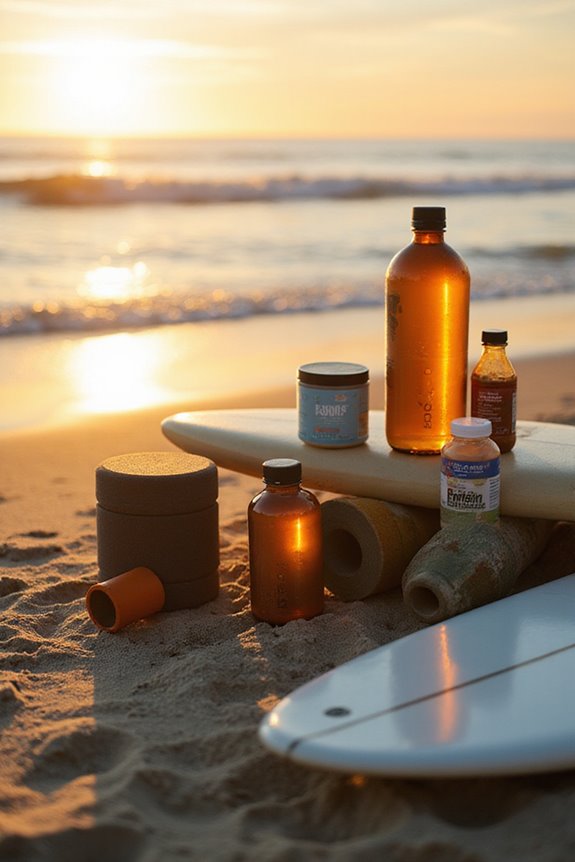If we get stung by a jellyfish, we should act quickly. First, we need to remove any tentacles with tweezers, then rinse the area with vinegar for at least 30 seconds. If vinegar isn’t available, use seawater. We can manage pain by soaking the sting in hot water or applying hydrocortisone cream. It’s vital not to use freshwater, rub the area, or apply harmful remedies. In severe cases, we must seek emergency help immediately. More information follows.
Key Takeaways
- Carefully remove tentacles with fine tweezers, avoiding rubbing or scraping the sting area.
- Rinse the affected area with vinegar for at least 30 seconds to deactivate nematocysts.
- Soak the sting area in hot water (110–113°F) for 20-45 minutes to alleviate pain.
- Apply hydrocortisone cream or lidocaine for itching and pain relief, and consider taking antihistamines.
- Seek emergency medical care for severe symptoms like difficulty breathing or significant skin reactions.
Immediate First Aid Actions
When we encounter a jellyfish sting, it’s vital to act quickly and follow the proper first aid steps to minimize discomfort and prevent further injury. First, we should carefully perform tentacle removal using fine tweezers to pluck any visible tentacles from the skin. It’s important to avoid rubbing or scraping the area, as this can release more venom.
Next, we should rinse the affected area generously with vinegar for at least 30 seconds to deactivate any nematocysts. If vinegar isn’t available, we can use seawater instead, but we must avoid fresh water, as it may activate remaining stingers. After rinsing, we shouldn’t rub the sting area to prevent further irritation. Additionally, having beach gear for comfort can help ensure a safer and more enjoyable experience while swimming or surfing.
Pain Management Techniques
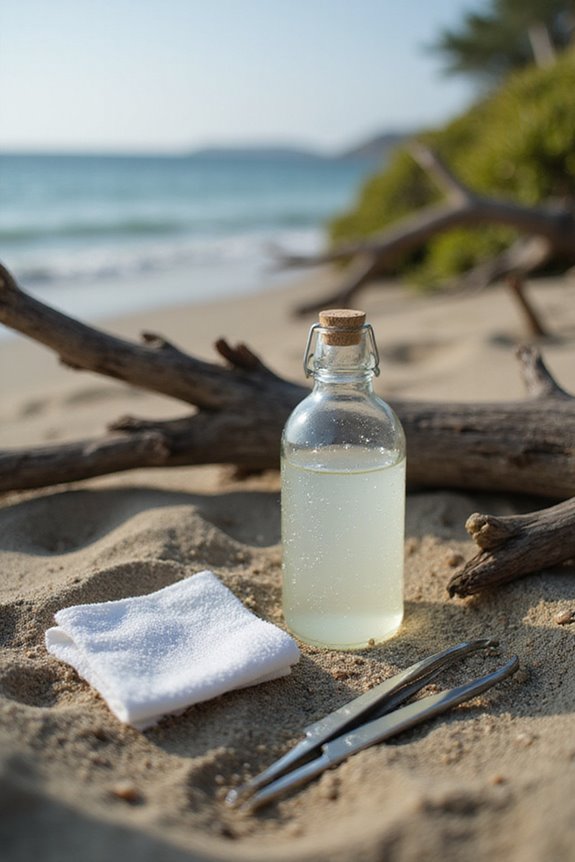
While experiencing a jellyfish sting can be extremely uncomfortable, we can implement several effective pain management techniques to alleviate symptoms.
Heat Application
Soaking the affected area in hot water (110–113°F) for 20–45 minutes helps reduce pain severity. The heat denatures jellyfish toxins and relaxes skin muscles, providing significant relief compared to cold water. Additionally, using a wetsuit with high-quality GBS seams can help minimize the risk of stings while surfing or swimming in jellyfish-prone areas.
Topical Treatments
Applying hydrocortisone cream can reduce itching and inflammation, while lidocaine acts as an analgesic. Over-the-counter pain relievers like ibuprofen or acetaminophen can also ease discomfort. Antihistamines, such as diphenhydramine, address allergic responses and itching.
Together, these methods can effectively manage pain and promote recovery after a jellyfish sting, allowing us to feel more comfortable and at ease.
What Not To Do After a Sting
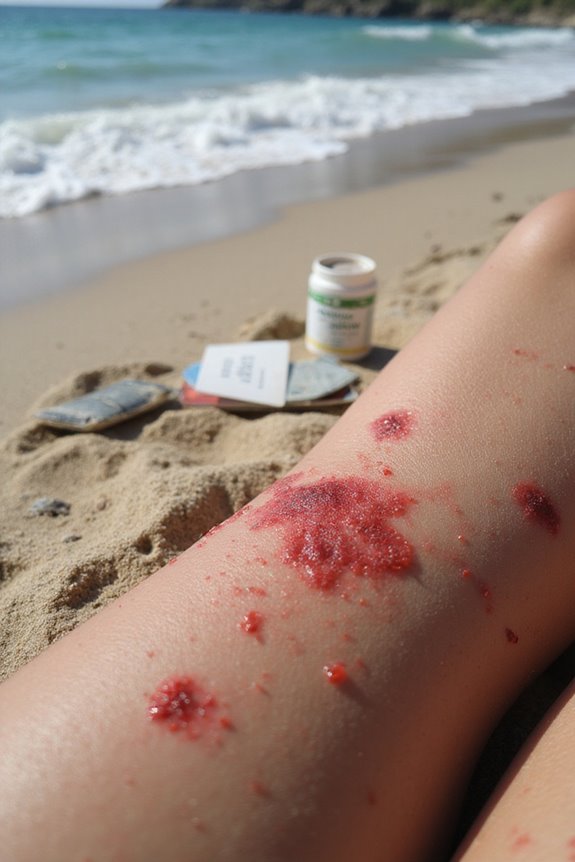
After a jellyfish sting, there are several critical actions we should avoid to prevent worsening the situation and to facilitate effective treatment.
- Don’t Rinse with Freshwater: Freshwater can trigger nematocysts, releasing more venom. Use vinegar or seawater instead.
- Avoid Rubbing the Area: Rubbing or scraping can release additional venom and worsen symptoms.
- Don’t Apply Harmful Remedies: Alcohol, urine, and meat tenderizer are common misconceptions that can aggravate the sting.
- Skip Pressure Bandages: Tight bandages can increase venom absorption and swelling.
- Don’t Delay First Aid: Promptly rinsing with vinegar and removing tentacles helps improve outcomes. Additionally, consider having emergency medical assistance ready, as prompt treatment can be crucial in severe cases.
When to Seek Emergency Medical Care
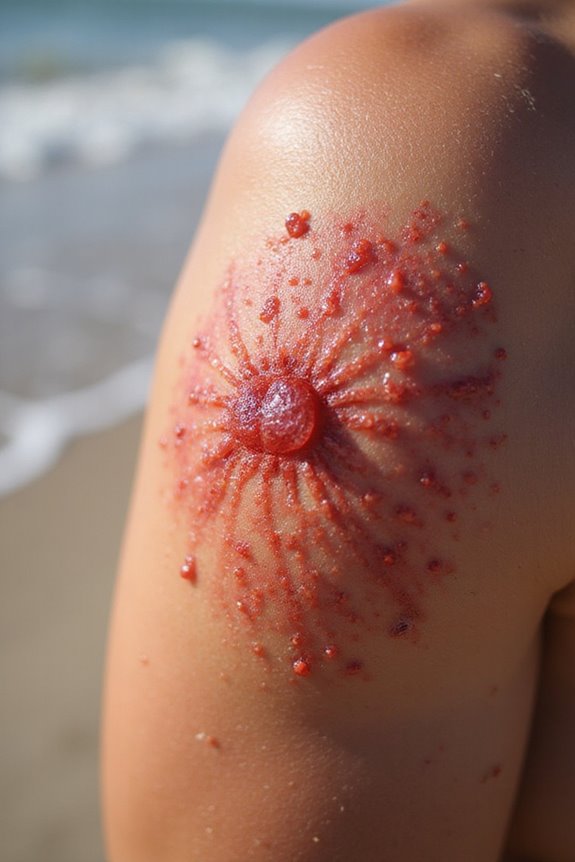
Recognizing the signs that indicate we need emergency medical care after a jellyfish sting is essential for our safety and well-being. If we experience difficulty breathing, chest pain, or profuse sweating, we must seek immediate help. Other symptoms, like fainting, altered consciousness, or severe pain that doesn’t improve with first aid, also require urgent attention.
Specific situations warranting emergency protocols include stings from dangerous jellyfish, such as the box jellyfish or those causing Irukandji syndrome. Additionally, if we notice significant skin reactions, worsening symptoms, or stings near sensitive areas like the eyes, we should act quickly. Proper symptom recognition can make a critical difference in our outcome after a jellyfish sting. Practicing mindfulness techniques can help us remain calm and focused in the face of such emergencies.
Diagnostic and Clinical Considerations
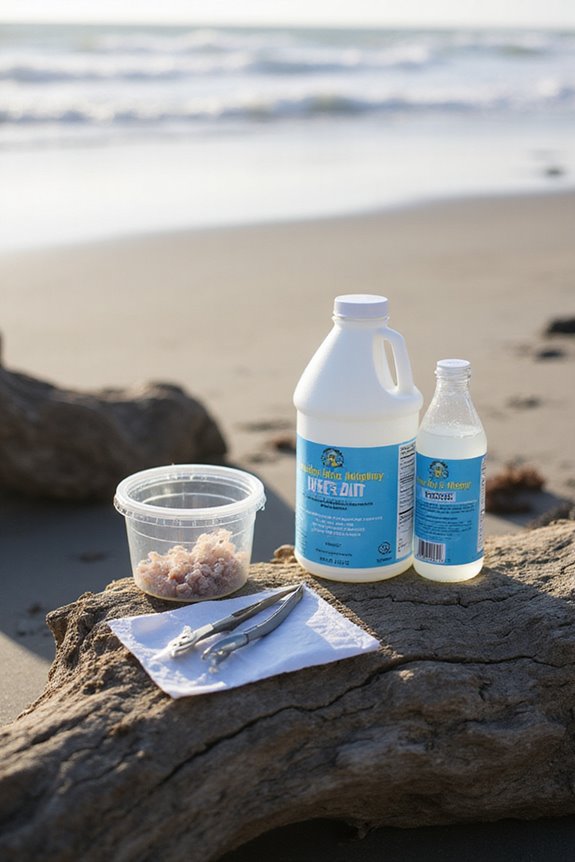
It’s important to monitor for local signs like swelling and throbbing pain, as well as systemic symptoms like nausea or difficulty breathing. We must also consider the pathophysiological considerations of venom, which can cause local inflammation and systemic effects, depending on the jellyfish species. In severe cases, recognizing delayed syndromes, such as Irukandji syndrome, is critical for timely intervention and management. Prompt evaluation and treatment can greatly improve outcomes for those affected. Additionally, knowing how to use super absorbent towels to manage the aftermath of a sting can be beneficial in easing discomfort.
Prevention and Preparedness Measures
When swimming in areas where jellyfish are present, taking preventive measures can greatly reduce the risk of stings. We should wear protective clothing such as full wetsuits or stinger suits, which cover most of our skin, including hoods, boots, and gloves. Simple barriers like nylon pantyhose can also help prevent stings from tentacle strands.
Environmental awareness is essential. We should avoid swimming during jellyfish bloom seasons and stay clear of washed-up jellyfish on the beach. Monitoring water temperature and tidal changes can help us anticipate jellyfish presence. Before entering the water, we must inspect for any visible jellyfish or tentacles. Carrying household vinegar and protective footwear can further prepare us for potential encounters. Additionally, using a high-quality wetsuit can enhance comfort and reduce the likelihood of stings.
Additional Resources for Jellyfish Stings
How can we best equip ourselves when dealing with jellyfish stings? Understanding jellyfish identification is essential for swift action post-sting. We should familiarize ourselves with local jellyfish species and their potential dangers.
Community awareness plays a significant role in prevention and response. We can encourage local beaches to post clear signage about jellyfish risks and treatment protocols. It’s also important to know emergency contacts, such as poison control centers, for immediate assistance.
Lastly, educational resources, including workshops and pamphlets, can enhance public knowledge on first-aid measures and proper care after a sting. By being informed, we can guarantee safety for ourselves and others while enjoying beach activities.
Frequently Asked Questions
Can I Apply Ice to a Jellyfish Sting?
We can use ice application for pain relief after a jellyfish sting. It helps reduce discomfort effectively, but we shouldn’t rely solely on it, as heat treatments are generally more effective for neutralizing toxins.
How Long Does Jellyfish Sting Pain Usually Last?
When we consider jellyfish types, sting symptoms vary. Typically, pain lasts one to two hours, but irritation can persist for days or even weeks, depending on the species and severity of the sting.
Are There Any Home Remedies That Work for Jellyfish Stings?
We’ve found that natural treatments like baking soda paste can soothe stings, while vinegar application may help deactivate nematocysts for some jellyfish. Let’s explore these remedies together for effective relief from discomfort.
Do Jellyfish Stings Always Require Medical Attention?
Not all jellyfish stings require medical attention; it depends on severity. We should assess symptoms and apply first aid techniques, like soaking in hot water, before seeking help for severe reactions or persistent pain.
Can I Swim Again After Being Stung by a Jellyfish?
After a sting, we need to prioritize recovery. Let’s guarantee all symptoms have resolved and follow swimming precautions like wearing protective gear. Gradually reintroducing water activities will help us stay safe while enjoying the ocean again.

